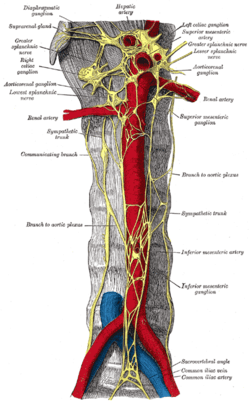Presacral neurectomy
Presacral neurectomy is one of the treatments for chronic pelvic pain and dysmenorrhea.[1] Lapraroscopic presacral neurectomy is an initial surgical intervention for chronic pelvic pain when medical therapy fails.[2]
| Presacral neurectomy | |
|---|---|
 The presacral plexus is excised during presacral neurectomy | |
| Specialty | Gynecology |
Mechanism
Most of the sensory pathways from the pelvic viscera pass through the superior hypogastric plexus and inferior hypogastric plexus to the spinal columns. The excision of presacral nerve trunk results in the obstruction of the pain pathway from the hypogastric plexi to the spinal cord. Presacral neurectomy denervates the uterus and causes loss of some bladder sensation.[3] It is believed that pain fibers from the ovary and distal fallopian tubes travel through the ovarian plexus to the vagus nerve, and therefore, bypass the superior hypogastric plexus.[1]
Procedure
First, a surgical incision is made of the peritoneum overlying the Sacrum#Promontory and extending this incision toward the aortic bifurcation. The inferior mesenteric artery is then identified as the left lateral border of the dissection. A surgical plane can then be carefully developed between the inferior mesenteric artery and the left common iliac vein.[1] The sacral promontory area is identified and can be infiltrated with vasoconstrictive solution or with the use of electrosurgery to reduce blood loss.[4]
Tools
Monopolar or bipolar forceps, or CO2 laser or neodymium can be used for this procedure.[4]
Route of surgery
Laparotomy or laparoscopy is the preferred route for PSN procedures. A PSN procedure can be safely completed in under an hour and patients discharged the day of surgery.[1][4]
Complications
Rarely chylous ascites (0.6%). 10–15% of patients experience minor bowel and urinary complaints.[1]
Efficacy
Presacral neurectomy is offered to patients for whom medical therapy for chronic pain relief has failed. The efficacy of the procedure is around 75-80%. Less than 1% of all patients suffer from major complications following the surgery.[5] There is no additional patient benefit of performing combined presacral neurectomy and uterine nerve ablation procedures.[1]
References
- Ramirez C, Donnellan N. (2017). "Pelvic denervation procedures for dysmenorrhea". Curr Opin Obstet Gynecol. 29 (4): 225–230. doi:10.1097/GCO.0000000000000379. PMID 28683027.CS1 maint: uses authors parameter (link)
- Chen, F. P. (January 2000). "Laparoscopic presacral neurectomy for chronic pelvic pain". Chang Gung Medical Journal. 23 (1): 1–7. ISSN 2072-0939. PMID 10746403.
- "Complications of laparoscopic presacral neurectomy". endopaedia.info. Retrieved 20 November 2017.
- Palomba S, Zupi E, Falbo A, Russo T, Tolino A, Marconi D, Mattei A, Zullo F. (2006). "Presacral neurectomy for surgical management of pelvic pain associated with endometriosis: a descriptive review". J Minim Invasive Gynecol. PMID 16962518.CS1 maint: uses authors parameter (link)
- Chen, FP (January 2000). "Laparoscopic presacral neurectomy for chronic pelvic pain". Chang Gung Medical Journal. 23 (1): 1–7. PMID 10746403.